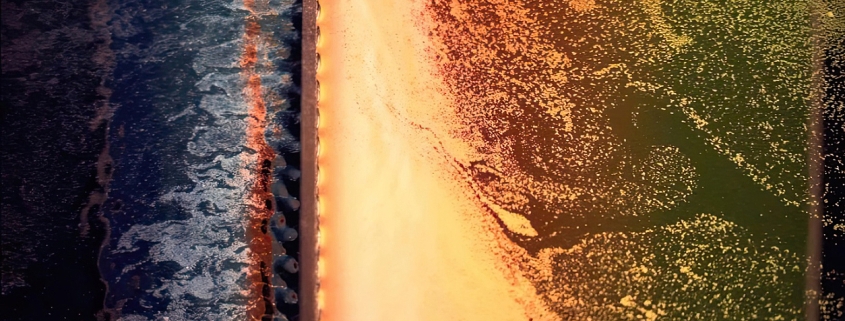TURBULENCE IN A CHANNEL
Gregor Eldarb
STATEMENT
Gregor Eldarb investigates the tensions created around the fluidity of matter, generating turbulence visualizations in water pools and reveling the heterogeneous rhythm of water current and their dynamics. Starting from Friedrich Christian Georg Ahlborn’s research on turbulences which insist on visualizing the active forces involved in moving around a stationary object in wind tunnels, Gregor Eldarb creates a cinematic apparatus consisting of a movable frame supporting a basin containing a mixture of black ink and silver pigment, a monitor installed above the frame in an angular position and a camera that captures the images projected on the basin surface which acts as a liquid mirror.
The flexible frame of the basin allows the liquid to move from left to right, producing a gravitational pendulum effect that generates a multitude of organic shapes on the surface. The basin’s structure also includes metal elements that function as experimental obstacles which generate tensions in the fluidity of the liquid mass, opposing resistance and altering the velocity of the liquid. This creates the turbulences − the fractures, the desynchronizations, the disturbances − that visually describe the nature of liquidity.
The liquid constitution of modernity (Zygmunt Bauman) establishes the metaphor of fluidity at the foundation of the society organization. The liquid nature understood both, in economic terms − with reference to the circulation of capital − and in sociological terms with regard to the constitution of social relations, allows for a continuous mobility that favors a state of partial autonomy. Liquid matter infiltrates, seeps, flows, changes its course, overflows and inundates, taking control of the space it occupies. However, its autonomy remains partial as long as it depends on the solidity of the structure that contains it.
The flexible framework of Gregor Eldarb’s experimental basin allows for the mobility of fluid matter, favoring incidental visual incongruities, speculating the organic transversality of liquidity and amplifying the interstices of tension that change the dynamics of matter’s circulation. The monitor installed at a distance of 50 cm above the frame projects a series of images constituted as templates for reflections, grids and color gradients, graphics illustrating surface tensions in fluid mechanics, or images from the silent film of William K.L. Dickson, from 1894, Edison Kinetoscopic Record of a Sneeze.
The video Notes on Turning presents an idiosyncratic selection of images capturing curiosities, architectural landmarks of the 1970’s, such as the Sainte-Alène church designed by architect Jacques Dupuis, modernist residential buildings, views from outside buildings, sculptures from the Royal Palace Square in Brussels, as well as pages from issue 185 of De Witte Raaf, published in January-February 2017. The succession of these images explores the possibilities of challenging the chronological practices of historiography, proposing to approach history as instantiation of an image/object. Replacing the chronological perspective with a circular one, Gregor Eldarb creates a kinematic device composed of a rotating frame and two glass panels that capture the mirrored reflections of objects and images on the rotating support. The double reflection of the images created by the overlapping of the two glass panels determines a multiplication effect of the photographed object.
In a complementary manner, the series of paintings entitled Weird Reflections offers a processual spatial analysis based on the composite study of architectural models, sculptures, texts, words from poems or architectural elements. Approached as inventions of experimental forms, Gregor Eldarb’s large-scale paintings visually trace unpredictable reflections, unusual projections and intersections of volumes that transcend the laws of geometry in an imaginary spectacle of the performativity of forms.

